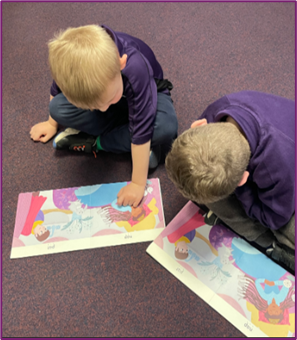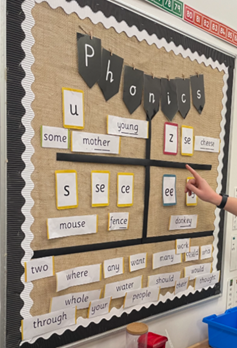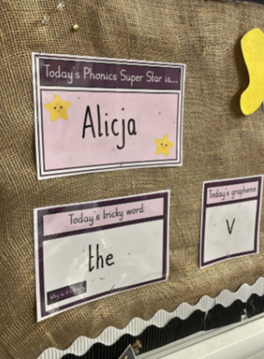Phonics
Subject Leader: Dale O'Brien



Intent:
At Corby Primary Academy, we are determined that every pupil will learn to read, regardless of their background, needs or abilities. Little Wandle Revised Letters and Sounds is our chosen systematic synthetic phonics programme. We strive to embed a positive attitude in reading for pleasure, as well as to teach the tools children need to use their reading skills as a vehicle for learning in all curriculum areas and life beyond school. Teachers and parents work in collaboration to ensure our pupils are given ample opportunities to build confidence and awareness of how their phonics knowledge can be applied to early reading. All adults interacting with children use consistent language year on year, ensuring children’s phonological understanding is developed in a holistic, inclusive environment using memorable routines. Texts are matched closely to children’s decoding level, allowing learners to develop self-assurance when exploring texts and apply a bold, confident attitude with their early experiences of reading.
Our curriculum in phonics ensures that all pupils:
- Understand the relationship between phonemes and the graphemes which represent them.
- Decode words (including reading tricky words) accurately and confidently.
- Develop fluency by providing opportunities for repeated reading both in and out of school.
- Experience regular exercises in letter formation and accurately using formation phrases.
- Accurately spell words by segmenting words into phonemes.
- Have frequent and varied opportunities to apply their phonics knowledge and observe adults modelling these skills.
Implementation:
In Nursery, we provide a balance of child-led and adult-led experiences for all children that meet the curriculum expectations for ‘Communication and language’ and ‘Literacy’.
These include:
- Sharing high-quality stories and poems,
- Learning a range of nursery rhymes and action rhymes,
- Activities that develop focused listening and attention, including oral blending.
- Attention to high-quality language.
We ensure Nursery children are well-prepared to begin learning grapheme-phoneme correspondences (GPCs) and blending in Reception by exposing them to the Little Wandle mnemonics and environmental sounds throughout the continuous provision.
The ‘Little Wandle Letters and Sounds Revised’ scheme includes:
- Revisiting previously taught GPCs,
- Reading familiar words that include recently taught GPCs,
- Learning a new GPC daily,
- Learning to blend and segment words that include the newly taught GPC, both in words and sentences,
- Writing a new GPC within a word.
‘Keep up’ sessions, also known as short interventions, are planned for children who are falling behind to ensure they make the same progress as their peers. These lessons match the structure of class teaching, and use the same procedures, resources and mantras, but in smaller steps with more repetition, so that every child secures their learning. Additionally, phonics is taught in streamed groups to enable precision teaching to take place; children are frequently assessed to ensure sessions are matched to their ability. Across Early Years and Key Stage One, adults apply phonics teaching across subjects, embedding the process in rich literacy environments.
Where necessary, explicit phonics teaching continues for some of our SEND or EAL pupils beyond KS1. These interventions are regularly assessed to ensure teaching is targeted and gaps are closed. In KS2, for those who still require phonics teaching, children receive specific and regular interventions to secure early phonic and reading skills. Every teacher in our school has been trained to teach reading, so we have the same expectations of progress. We all use the same language, routines and resources to teach children to read so that we lower children’s cognitive load.
Once children have mastered reading and blending phonemes within phase 2, they start to read short stories and texts that have words which include the sounds they know. Once children are secure, they begin to learn phase 3 digraphs and alternative graphemes for phonemes in phase 5. Whilst children are learning to decode words in texts, we also focus on prosody and comprehension in grouped reading sessions to formatively assess children’s progress.
To further embed a pleasure for reading, children take home a decodable reading book that contains learnt GPCs and tricky words. This allows children to have additional practice and provides opportunities for reading success to be shared with their family.
Reading for pleasure books also go home for parents to share and read to children. Children choose these reading for pleasure books from their class library. We also use the Little Wandle Letters and Sounds Revised parents’ resources to engage our families and share information about phonics, the benefits of sharing books, how children learn to blend and other aspects of our provision, both online and through workshops.
Impact:
Assessment for learning is factored into daily lessons to identify children needing keep-up support through:
- Weekly in the lesson reviews to assess gaps,
- Daily reviews within sessions to ensure all children demonstrate their understanding of revisited and new GPCs and tricky words,
- Within groups reading sessions to assess application of phonics knowledge to texts.
Summative assessment is used every six weeks to assess progress and identify gaps in learning that need to be addressed as well as identify any children needing support.
The systems used for phonics teaching are monitored through learning walks and tracking pupil progress. This ensures that all our children build a strong platform of literacy skills: reading, writing and spelling, increasing their success in accessing other areas of the curriculum. This will foster children to become independent readers and develop a love of reading throughout their time at Corby Primary Academy.


Little Wandle Resources for Parents
For more information about how to pronounce sounds, please click here. Notice how the children don’t add an ‘uh’ sound at the end, so they say: ‘t’ not ‘tuh’. Use the downloadable information to help your child remember how to write their letters and say their sounds.
Click here to watch videos and downloads that show parents how we teach your child specific aspects of phonics in class.
Click here to access resources that will help you support your child with saying their sounds and writing their letters. There are also some useful videos so you can see how they are taught at school and feel confident about supporting their reading at home.

